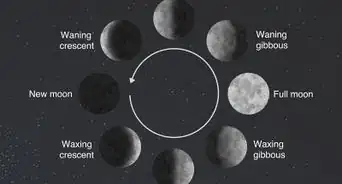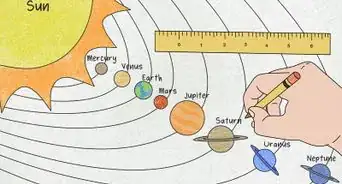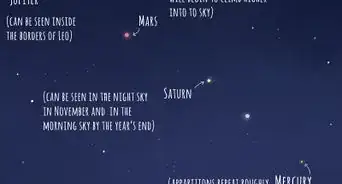This article was co-authored by Bess Ruff, MA. Bess Ruff is a Geography PhD student at Florida State University. She received her MA in Environmental Science and Management from the University of California, Santa Barbara in 2016. She has conducted survey work for marine spatial planning projects in the Caribbean and provided research support as a graduate fellow for the Sustainable Fisheries Group.
There are 8 references cited in this article, which can be found at the bottom of the page.
This article has been viewed 34,188 times.
Shooting stars, black holes, and space travel. Space captures our imagination and makes us wonder about our place in the universe. Advances in technology allow humans to observe and explore space like never before. Find out more ways to learn the science behind space exploration and activities that you can participate in to learn independently.
Steps
Understanding the Basics
-
1Study the major points about space. These are the Big Bang, the solar system, and the theory of relativity. They form the bedrock of space knowledge. Having even a basic grasp on these topics will give you a great jumping-off point for learning more.[1]
- Visit your local library to find books about space and consult online encyclopedias.
- Libraries and civic center often have lectures and presentations on educational topics, including space.
- Take an introductory class on astronomy at your school.
-
2Watch educational shows about space. There have been very entertaining and informative shows produced about space. Check out the Cosmos series, the older episodes hosted by famed cosmologist Carl Sagan, as well as the most recent version with physicist Neil deGrasse Tyson.
- Another great option is The Universe on the History Channel.
Advertisement -
3Plug into pop culture. Popular culture is full of science fiction themed shows and literature that deal with space. While these are works of fiction, they can be based on science and quite educational. It's a great starting point, especially if you find traditional learning to be boring.
- Start with shows like Star Trek, Firefly, and Lost in Space.
- There is a wealth of classic literature about space travel. Perhaps the best and most well known novel is 2001: A Space Odyssey by Arthur C. Clarke. Other writers include Philip K. Dick, Isaac Asimov, and Robert Heinlein.
-
4Grasp the size of the universe. Distances in spaces are enormous and hard for the human brain to understand.[2] Check out this interactive visualization to help put things in perspective: https://scaleofuniverse.com/.
-
5Read about space current missions. The International Space Station, the Juno mission to Jupiter, and Curiosity Mars Rover are happening right now. The National Aeronautics and Space Administration (NASA) is the world leader in space exploration. As a large, government-funded organization, it is always conducting research and planning for future missions.
- Also check out educational videos about the current projects happening at NASA at: https://www.dvidshub.net/unit/NASA.
-
6Visit a NASA facility. There are locations throughout the country including the Space Center in Houston, the Kennedy Space Center in Florida, and the Jet Propulsion Lab in California, among others. The complete list of facilities is can be found at: http://www.visitnasa.com/nasa-visitor-centers.
Using Technology
-
1Utilize online learning websites. Coursera, Khan Academy, and FutureLearn have well developed online classes. You can take engaging courses on astronomy, the history of the universe, and the formation of the solar system. New courses are posted frequently, so check back often.
-
2Read blogs about space. With frequent postings, you can keep up to date on the latest space news and insightful commentary. There are many out there, but some popular ones are the Planetary Society, Explore Deep Space, and the NASA blog.[3]
-
3Download space apps to your phone. There are apps that help you identify stars in the night sky, allow you to track satellites, and look out for solar flares, amongst other things.[4]
- Check out NASA’s International Space Apps Challenge, ISS Spotter, and Star Chart.
-
4Keep up to date on current space exploration. The USA, Russia, Japan, China, India, and several other countries have active space programs. While human travel to space is mostly restricted to the International Space Station, rovers and satellites are being launched to planets and moons in the solar system. There are also plans to send humans to Mars in the 2030s.[5]
- NASA plans to launch a new robotic science rover to Mars in 2020. It will conduct further research on the red planet and answer key questions about the possibility of life on Mars.[6]
- Stay informed of everything that is sent into space. Launches are very frequent, sending up satellites and supplies for the International Space Station.
- Check out the work of Space X. This private company is building and testing a fleet of spaceships that aims to create a space tourism industry, holds contracts with NASA, and wants to build a colony on Mars.[7]
Exploring for Yourself
-
1Go places! There are many historical and educational institutions you can visit to learn about space. You’ll be able to find spaceship models (or even the real thing), artifacts and memorabilia from previous space programs, personal items from astronauts, meteorites, and moon rocks.
- Inquire if your local museums have a permanent or visiting exhibit about space.
- Visit your local planetarium for an exhibit on stars and planets. Find the closest one to your location at: http://www.go-astronomy.com/planetariums.htm
- Take a road trip to Roswell, New Mexico, the site of a purported alien visit in 1950s. You’ll find plenty of alien folklore with the added benefit of being in perfect stargazing country.
-
2Look at photos of space. Thankfully we have tools that help us see farther into space than ever before. High-powered telescopes based on Earth and in space allow us to peer into the far corners of the universe.
- You can begin by checking out incredible images from the Hubble telescope (http://hubblesite.org/gallery/), NASA's own collection of photos, as well as the European Space Agency’s collections (http://www.esa.int/spaceinimages/Images).
-
3Stargaze. Observing the night skies can be a rewarding experience, even more so if you can get away from the city. Many celestial bodies are visible with the naked eye. Planets, constellations, satellites, and shooting stars can all be observed if you look carefully. The ideal conditions for observation are a clear night with good weather and a location far from big population centers.[8]
- Check to see what objects will be visible on a particular night so you know what to look for.
- Check the weather report for rain or clouds.
- Consider planning a camping trip to coincide with a meteor shower.
- National and state parks have campgrounds and the added benefit of being away from cities with light pollution.
- You can use binoculars or a personal telescope to zoom in on the stars.
-
4Join a space and astronomy club at your school. If your school doesn’t have a space club, you can start one! Get with a group of people who share your interest in space. Together you can discuss the latest space news, invite guest speakers, and build models of the solar system and spaceships.
Community Q&A
-
QuestionWhat if I live in Europe where there aren't any NASA facilities?
 Community AnswerNASA isn't the only agency that can teach you about space. You don't even have to go to a NASA center! There is a ton of information online. NASA even has its own website. In Europe, there is a space agency called the European Space Agency. It also has its own website. You don't have to visit a facility to learn more about space. You can buy books, read things online, talk to astronomy experts, etc.
Community AnswerNASA isn't the only agency that can teach you about space. You don't even have to go to a NASA center! There is a ton of information online. NASA even has its own website. In Europe, there is a space agency called the European Space Agency. It also has its own website. You don't have to visit a facility to learn more about space. You can buy books, read things online, talk to astronomy experts, etc. -
QuestionIs it too late for me as a teen to start showing interest in space when I've never really shown interest?
 Community AnswerNot at all, it's never too late to develop a new interest or hobby.
Community AnswerNot at all, it's never too late to develop a new interest or hobby. -
QuestionWho should I invite to my astronomy club?
 FreyrTop AnswererYou can invite your friends, and anybody who noticeably likes space. You can ask your school if you're allowed to put up posters for your club (they'll most likely let you) and make posters either by hand or by printing them off. If your school has a newsletter (or any social media accounts), you can ask if your space club can feature in it. Make sure you get your club on your school's list of clubs if they have one.
FreyrTop AnswererYou can invite your friends, and anybody who noticeably likes space. You can ask your school if you're allowed to put up posters for your club (they'll most likely let you) and make posters either by hand or by printing them off. If your school has a newsletter (or any social media accounts), you can ask if your space club can feature in it. Make sure you get your club on your school's list of clubs if they have one.
Warnings
- Never use a telescope to look directly at the sun as it can cause blindness.⧼thumbs_response⧽
References
- ↑ https://spaceplace.nasa.gov/menu/space/
- ↑ https://energyeducation.ca/encyclopedia/Size_of_the_universe
- ↑ https://blog.feedspot.com/space_blogs/
- ↑ https://eyes.nasa.gov/mobile-apps.html
- ↑ https://www.nasa.gov/content/journey-to-mars-overview
- ↑ http://mars.nasa.gov/programmissions/missions/future/mars2020/
- ↑ https://www.spacex.com/human-spaceflight/mars/
- ↑ https://www.asc-csa.gc.ca/eng/astronomy/tips-tricks/stargazing-tips.asp







































































